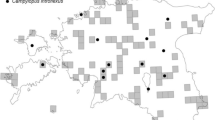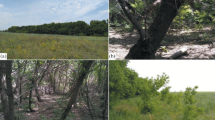Abstract
Woodsia ilvensis has become extinct from its last known natural localities in Estonia and has not been rediscovered since 1977. This fern grew in northern and north-western Estonia in areas of suitable habitat. Considering that habitat conditions may have changed in previous localities, an experimental project was started to test if it would be possible to reintroduce W. ilvensis into new localities where suitable habitat conditions exist. Two experiments were performed, one on an old stone wall, constructed of stones collected from the surrounding fields, and another on two granite boulders in two localities, one where the surrounding soil was acidic, and the other where the soil was basic. The plants were grown from spores of wild provenance received from Finland via the seed and spore exchange system of botanical gardens. Results confirmed that individual plants can establish and persist for at least 10 years on stone walls without maintenance. The experiment on boulders failed, as plants did not establish there. Young, 2-year old mature individuals proved to be the best stage for planting out onto the stone walls in this case study. The best indicators for selecting suitable habitat were characteristic plant species of the natural community. Here I discuss the experimental methods used and first results of the experiment.


Similar content being viewed by others
Abbreviations
- TAA:
-
Estonian University of Life Sciences, Institute of Agricultural and Environmental Sciences, herbarium
- TAM:
-
Estonian Museum of Natural History, botanical collections
- TU:
-
University of Tartu, Museum of Natural History, herbarium
References
Åberg G (1934) Floristische Beobachtungen bei Baltischport und auf den Inseln Rågöarna in NW-Estland. Memo Soc pro Fauna et Flora Fennica 10:222–239
Aguraiuja R (2001) Eesti kaitstavate sõnajalgade uurimine Tallinna Botaanikaias. Tallinna Botaanikaia uurimused 5. Taim ja keskkond, pp 85–98
Aguraiuja R (2005) Hawaiian endemic fern lineage Diellia (Aspleniaceae): distribution, population structure and ecology. Ph.D. Dissertation, University of Tartu
Aguraiuja R, Moora M, Zobel M (2004) Population stage structure of Hawaiian endemic fern taxa of Diellia (Aspleniaceae): implications for monitoring and regional dynamics. Can J Bot 82:1438–1445
Cousens MI (1988) Reproductive strategies of pteridophytes. In: Lovett-Doust J, Lovett-Doust L (eds) Plant reproductive ecology. Patterns and strategies, Oxford University Press, New York, pp 307–328
Davis AS, Jacobs DF (2005) Quantifying root system quality of nursery seedlings and relationship to outplanting performance. New Forests 30:295–311
Dyer A, Lindsay S, Lusby P (2001) Woodsia ilvensis in Britain—last chance or lost cause? Pteridologist 3:137–145
ERT (2004) The Riigi Teataja (Estonian State Gazette), 21.05.2004, 44, 313
Falk DA, Millar CI, Olwell M (eds) (1996) Restoring diversity: strategies for reintroduction of endangered plants. Island Press, Washington, DC
Glazkova (Krasnoschokova) EA (1996) On some rare plant species in the islands of eastern part of the Gulf of Finland. Bot Zhurn 81:111–114
Gorbunov YN, Dzybov ZE, Kuzmin ZE, Smirnov IA (2008) Methodological recommendations for botanical gardens on the reintroduction of rare and threatened plants. Botanic Gardens Conservation International, Moscow
Guerrant EO Jr. (1996) Designing populations: demographic, genetic, and horticultural dimensions. In: Falk DA, Millar CI, Olwell M (eds) Restoring diversity: strategies for reintroduction of endangered plants. Island Press, Washington, DC, pp 171–207
Hegi G (1984) Illustrierte flora von mitteleuropa. band I. Teil 1. pteridophyta. Verlag Paul Parey, Berlin und Hamburg
Hein V, Puusepp V (1962) Kahe haruldase sõnajalalise levikust Eestis. LUS-i aastaraamat 55. Tartu, pp 79–83
Hultén E (1971) Atlas över växternas utbredning in Norden. Generalstabens Litografiska Anstalt, Stockholm
Hultén E, Fries M (1986) Atlas of north European vascular plants north of the tropic cancer. I. Koeltz Scientific Books in Königstein, Germany
Ingelög T, Andersson R, Tjernberg M (1993) Red data book of the Baltic region. I. lists of threatened vascular plants and vertebrate. Swedish Threatened Species Unit, Uppsala
IUCN/SSC Guidelines for reintroductions (1995) Approved by the 41st Meeting of the IUCN Council, Gland, Switzerland
Jacobs DF, Ross-Davis AL, Davis AS (2004) Establishment success of conservation tree plantations in relation to silvicultural practices in Indiana, USA. New Forests 28:23–36
Jones DL (1987) Encyclopedia of Ferns. Lothian Publishing Company Pty Ltd, Melbourne, Sydney, Auckland
Kala E (1995) Geological map of Estonia. Geological Survey of Estonia, Tallinn
Kukk T, Kull T (eds) (2005) Atlas of the Estonian flora. Estonian University of Life Sciences, Tartu
Lilleleht V (ed) (1998) Red data book of Estonia. Comission for Nature Conservation of the Estonian Academy of Sciences, Tartu
McHaffie H (2004) Woodsia ilvensis re-introduction programme. Pteridologist 4:67
Mossberg B, Stenberg L (2007) Den nya nordiska floran. PDC Tangen, Norway
Primack RB (1996) Lessons from ecological theory: dispersal, establishment, and population structure. In: Falk DA, Millar CI, Olwell M (eds) Restoring diversity: strategies for reintroduction of endangered plants. Island Press, Washington, DC, pp 209–233
Tolmatšov AI (1974) Flora regionis boreali-orientalis territoriae Europaeae URSS. Tomus I. polypodiaceae-graminae. Nauka, Moscow
Valee L, Hobgin T, Monks L, Makinson B, Matthes M, Rossetto M (2004) Guidelines for the translocation of threatened species in Australia, 2nd edn. Australian Network for Plant Conservation, Canberra
Werth CR, Cousens MI (1990) Summary: the contributions of population studies on ferns. Am Fern J 80:183–190
Acknowledgments
I would you like to thank all reviewers for their critical notes, linguistic suggestions and valuable comments what helped to improve the manuscript.
Author information
Authors and Affiliations
Corresponding author
Rights and permissions
About this article
Cite this article
Aguraiuja, R. Reintroduction of the endangered fern species Woodsia ilvensis to Estonia: a long-term pilot study. Biodivers Conserv 20, 391–400 (2011). https://doi.org/10.1007/s10531-010-9970-2
Received:
Accepted:
Published:
Issue Date:
DOI: https://doi.org/10.1007/s10531-010-9970-2




